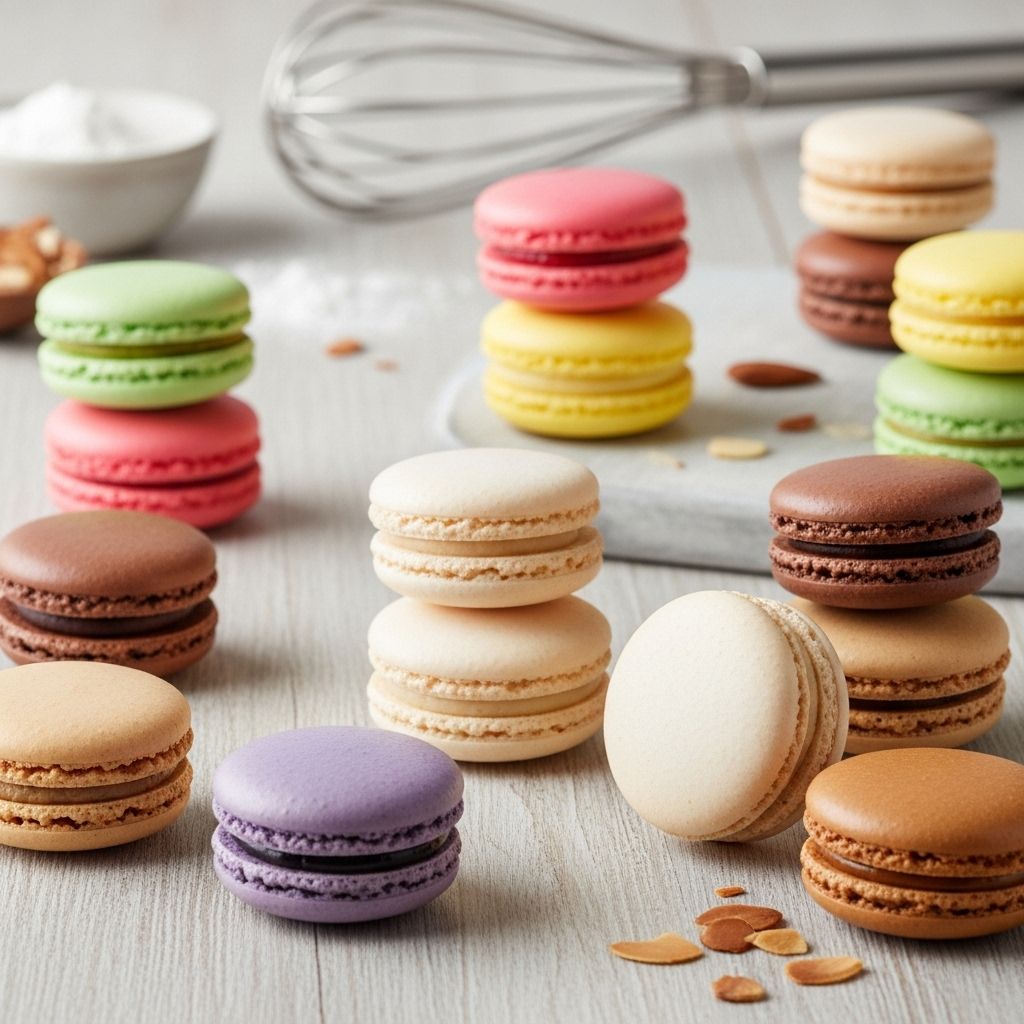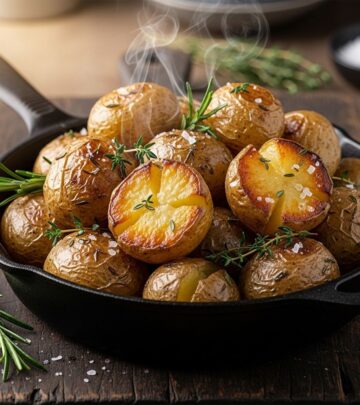French Macaron Recipe: 8 Essential Steps For Perfect Macarons
Discover every step to achieve flawless French macarons, from mixing and piping to troubleshooting and creative flavor ideas.

Image: HearthJunction Design Team
Mastering Macarons: A Complete Guide to Perfect French Macarons
French macarons are one of pastry’s most elegant and challenging cookies. With their crisp eggshell exteriors, chewy interiors, and endless possibilities for creative fillings and colors, these meringue-based treats delight dessert lovers worldwide. This comprehensive guide will walk you through every step of the macaron process, from preparing ingredients with precision to achieving smooth tops, classic ‘feet,’ and delectable buttercream fillings. Whether you’re a novice or a seasoned baker, you’ll find the secrets to macaron mastery right here.
What Are French Macarons?
French macarons are delicate sandwich cookies made from whipped egg whites, almond flour, and powdered sugar. The resulting shells are crisp on the outside and soft on the inside, sandwiched around rich fillings like buttercream, ganache, or jam. Unlike coconut macaroons, French macarons are known for their vibrant colors, smooth tops, and distinctive ruffled ‘feet.’
Ingredients for Macaron Shells
- 1 3/4 cups (210 g) powdered sugar
- 1 cup (95 g) almond flour, finely ground
- 3 large egg whites, room temperature
- 1/4 teaspoon kosher salt
- 1/4 cup (50 g) granulated sugar
- 1/2 teaspoon vanilla extract (optional)
- Gel food coloring, as desired
The Essential Steps to Making Macarons
1. Prepare the Dry Ingredients
Begin by combining the powdered sugar and almond flour in a food processor. Pulse several times to ensure the mixture is ultra-fine and homogeneous. This step is worth repeating, even with pre-fine almond flour, as it ensures your shells have a smooth, professional finish. After pulsing, sift the mixture through a fine-mesh sieve into a large bowl. If any coarser almond bits remain, discard them or pulse further until fine. Sifting 2-3 times is an expert trick for ultra-smooth tops.
2. Make the Meringue
In a separate bowl, use the whisk attachment of a stand mixer or a hand mixer to beat the room-temperature egg whites with a pinch of salt until frothy. It’s crucial to add salt, as it helps stabilize the meringue. Once frothy and no longer translucent, gradually add the granulated sugar, a little at a time, while continuing to whip. This gradual addition is key to retaining the air and achieving a sturdy meringue. Continue whipping on medium-high speed until stiff, glossy peaks form – you should be able to turn the bowl upside down without the meringue slipping.
3. Add Flavor and Color
If you want colored macarons, add a few drops of gel food coloring (never liquid, which can destabilize the batter). Add vanilla extract if desired. Avoid over-mixing at this stage; just incorporate the color and flavor until evenly distributed.
4. Macaronage: Folding the Batter
Macaronage is the technique of folding the dry ingredients into the meringue. Add one third of your sifted almond-powdered sugar mixture to the meringue and fold gently, scooping from the bottom and turning the bowl as you go. Repeat in two more additions. The goal is a glossy, ‘lava-like’ batter that flows in thick ribbons off the spatula and merges back into itself after a few seconds. To test, let the batter fall from your spatula and see if you can form a figure ‘8’ without the ribbon breaking.
- If undermixed, the batter will be too thick and the shells will be lumpy.
- If overmixed, the batter will be thin and spread out, leading to flat, cracked shells.
5. Piping the Shells
Transfer the batter to a piping bag fitted with a round tip (about 1/2 inch wide). Line baking sheets with parchment paper or silicone mats. Pipe circles of batter about 1.5 inches in diameter, spacing them 1 inch apart. Hold the piping bag vertically and apply even pressure, releasing just as the batter reaches the desired size. To fix any peaks, gently tap the tray on the counter several times to smooth the tops and release air bubbles.
- Optional: Pop air bubbles with a toothpick to prevent hollow shells.
6. Resting the Shells
Let the piped macaron shells rest at room temperature, uncovered, for 30–60 minutes. They’re ready to bake when the tops are dry and no longer sticky to the touch. This resting period helps develop the signature ‘feet’ (ruffled bottoms) during baking.
7. Baking the Macarons
Preheat your oven to 300°F (150°C). Bake the rested macarons for 17–20 minutes, rotating the trays halfway through for even baking. The shells should rise, stay shiny, and develop ruffled feet. They are done when they can be gently lifted off the baking surface without sticking.
8. Cooling
Let the shells cool completely on the tray before attempting to remove them. Warm shells can stick and break.
How to Make Classic Buttercream Filling
Buttercream is a popular choice for macaron fillings. Try this simple recipe:
- 2 sticks (1 cup) unsalted butter, softened
- 3 cups (375 g) powdered sugar, sifted
- 1 teaspoon vanilla extract
- 4 tablespoons heavy cream
- Pinch of salt
Beat the softened butter until light and fluffy. Sift in powdered sugar gradually and beat until incorporated. Add vanilla, salt, and heavy cream (one tablespoon at a time) until smooth and pipeable. You can also add gel food coloring for vibrant variations.
Other Filling Ideas
- Chocolate ganache
- Lemon curd
- Fruit jams or preserves
- Cream cheese frosting
- Salted caramel
Assembling & Maturing the Macarons
- Pair up cooled shells by size.
- Pipe a dollop of filling onto the flat side of one shell.
- Gently sandwich with a matching shell, twisting lightly to spread the filling.
- For best texture, refrigerate assembled macarons at least 24 hours in an airtight container before serving. This maturation process allows the shells to absorb moisture from the filling, creating the ideal chewy texture.
Expert Tips for Perfect Macarons
- Use a kitchen scale for accuracy.
- Sift dry ingredients multiple times for the smoothest shells.
- Use room temperature egg whites for better meringue stability.
- Pipe batter onto templates or guides for uniform size.
- Rest shells until dry – don’t skip this step!
- If your kitchen is humid, use a fan to speed up the drying process.
- Let filled macarons mature overnight for the best bite and flavor.
Troubleshooting Common Macaron Problems
| Problem | Possible Cause | Solution |
|---|---|---|
| Cracked shells | Insufficient resting; overwhipped meringue; oven too hot | Rest shells fully; check oven temperature; don’t overwhip egg whites |
| Hollow shells | Overmixed or undermixed batter; oven temperature fluctuations | Master macaronage technique; bake with oven thermometer |
| No feet | Batter too wet; insufficient resting; under-mixed meringue | Rest longer; mix properly; avoid humid conditions |
| Lopsided shells | Uneven piping; oven hot spots | Pipe perpendicular; rotate tray halfway through baking |
| Sticky bottoms | Underbaked | Bake longer or reduce temperature slightly |
Flavor and Color Variations
Get creative! Macarons are famous for their variety. Here are a few ideas:
- Color: Use gel food coloring for vibrant shells – pink, purple, yellow, green… the choice is yours.
- Extracts: Add a few drops of almond, coffee, or lemon extract to the meringue.
- Fillings: Mix and match buttercream, ganache, fruit preserves, or curd.
- Decorations: Dust with edible glitter, sprinkles, or cocoa powder before baking.
Storage and Shelf Life
- Store filled macarons in an airtight container in the refrigerator for up to 1 week.
- For longer storage, freeze macarons (assembled or shells only) for up to 1 month. Thaw in the refrigerator before serving.
Frequently Asked Questions (FAQs)
Q: Can I make macarons without a food processor?
A: Yes. While a food processor helps achieve finer almond flour and smoother tops, you can sift your dry ingredients multiple times to mimic that effect. The macarons might have a slightly bumpier texture but will still taste delicious.
Q: Why did my macarons crack?
A: Cracked macarons usually result from not letting the shells rest enough before baking or from an oven temperature that’s too high. Make sure the tops are dry to the touch before baking, and use an oven thermometer for accuracy.
Q: Which food coloring is best for macarons?
A: Gel food coloring is best because it delivers vibrant hues without adding excess moisture that can negatively impact the batter.
Q: How do I know when the macarons are done baking?
A: The shells should have developed feet and come off the baking surface cleanly. If they stick or the bottoms are still wet, bake for a few more minutes.
Q: Can I freeze macarons?
A: Yes. Place in a single layer, freeze until solid, then store in an airtight container. Thaw in the fridge before serving for best texture.
Conclusion
With patience and practice, anyone can create beautiful French macarons at home. Remember to focus on sifting, proper macaronage, resting time, and baking accuracy. Don’t be afraid to experiment with colors and fillings to make these iconic cookies truly your own. Happy baking!
References
Read full bio of medha deb












